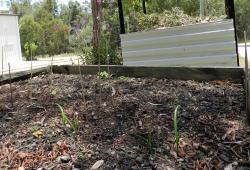With regard to tap water vs. bottled vs. distilled;
The tap water here is relatively high quality and very palatable most of the year, however there is an occasional algae bloom which occurs in the reservoir during the warm season, which triggers an increase in treatment chemicals. Both the algae and the extra chemicals affect the flavor, so I maintain a drinking water cooler using water from a small local treatment facility. The pH of the tap water is 8.5+, and contains residual chloramine as part of the antimicrobial treatment. Unlike chlorine, chloramine is very persistent and won't simply dissipate/evaporate as chlorine would. Ever since the late 80's when the water district switched from chlorine to chloramine, I have noticed that my plants - particularly containerized plants - haven't looked as healthy as they used to. Part of this is probably due to the high pH locking up nutrients, but the timing suggests that chloramine plays a part.
http://www.ebmud.com/water-and...
The water all comes from the Sierra, but there are 6 separate treatments plants and water quality zones. Because their water is stored in earthen reservoirs, the Sobrante and San Leandro zones show markedly higher levels of TDS, Chlorides, Sulfates and Specific conductance. I'm not sure at what point these things become detrimental to plants, but I suspect they're not good.
The drinking water I buy for the water cooler is Sobrante zone water which goes through a multi-step treatment process including reverse-osmosis, ozonation, polishing and mineral supplementation via a softener. Finished product is pH 6-6.5. No fluoride is added. I don't know about its mineral or salt levels, so I don't normally use it for any plants.
I grow several species of Amaryllids which produce "winged" (flat) seed such as Hippeastrum, Cyrtanthus and Habranthus, and one of the ways I like to germinate seeds of the more valuable or "touchier" ones is by floating them on water. I've noticed some things about different types of water when doing this. The R-O drinking water with the low pH stimulates germination to a remarkable degree, but molds seem to develop fairly quickly, necessitating frequent water changes. Same with distilled water and grocery store bottled drinking water. Ironically, the chloramine in the tap water resists the growth of mold and fungus, so for the overall best seed sprouting and initial growth I use tap water or my own pH-corrected tap water, acidified with vinegar.
Daylily seeds might be the easiest and most tenacious seeds I've ever grown, with the exception of radish. After drying for a week up to 3 months, I store them in the refrigerator, damp, in manila coin envelopes inside ZipLoc bags. After a few months the envelopes develop a good amount of mold, and the occasional "squisher" will rot, but the others in the envelope seem to not mind, and that's when I find little white sprouts emerging from most of the seeds. I like to plant when they have up to an inch of root, so that I have a much better idea of how many plants I am going to end up with in a pot, and also because I know which way is up. This isn't to say that any of this is necessary, because planting them directly in the garden shortly after harvest works very well too. I grow them in pots because birds, gophers, moles and other critters would leave me with too many dead, missing and/or unidentified seedlings, and because I don't want to waste garden space on the runts. I like the flexibility pots offer, because I may sprout 30 seeds of a cross, but end up lining out only 10-15 of the strongest plants. Also, some of the crosses that seemed magical when pollinating are less exciting months later when it's time to line out a limited number of seedlings.
I've used Physan 20 as a seed/cutting disinfectant with good results, and now that I know proper dilution rates for hydrogen peroxide, I'll be trying that. One year I used a Physan 20 solution to moisten the envelopes in the ZipLoc bags and even months later, they were almost devoid of mold. It was a nice touch, but it didn't seem to affect the overall success of the seeds & seedlings as far as I could tell. I've done all sorts of questionable things to daylilies, and they tend to keep plugging along. Over the years, the only thing that reliably ensures that the seeds won't grow is if I fail to plant them, so if people just stick to the basics and plant their seed, they'll be OK.
I fertilize everything that shows green, but I'm not that regular about it. The daylily seed doesn't have all that much energy stored in it, and my favorite seed-starting mediums (peat or coir mixed with perlite) don't have any significant nutrients. I found that if some sort of full-spectrum fertilizer isn't applied shortly after germination, the leaves grow thin and floppy, even with good light. This was particularly noticeable when using coir, and I had to supplement my fertilizer (Dyna-Gro Foliage Pro 9-3-7 - a "complete" fertilizer) with a Calcium-Magnesium liquid (General Hydroponics CALi MAGic) in order to correct the problem. As always, fertilization (and warmth) should be commensurate with light levels.
Ken
